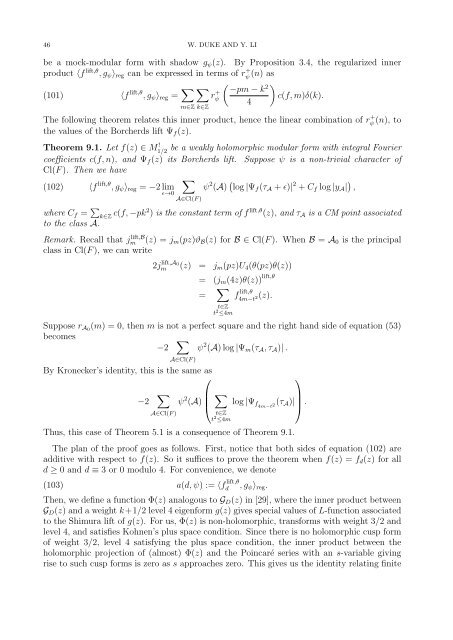Mock-modular forms of weight one - UCLA Department of Mathematics
Mock-modular forms of weight one - UCLA Department of Mathematics
Mock-modular forms of weight one - UCLA Department of Mathematics
Create successful ePaper yourself
Turn your PDF publications into a flip-book with our unique Google optimized e-Paper software.
46 W. DUKE AND Y. LI<br />
be a mock-<strong>modular</strong> form with shadow g ψ (z). By Proposition 3.4, the regularized inner<br />
product 〈f lift,θ , g ψ 〉 reg can be expressed in terms <strong>of</strong> r + ψ<br />
(n) as<br />
(101) 〈f lift,θ , g ψ 〉 reg = ∑ ∑<br />
( )<br />
−pm − k<br />
r + 2<br />
ψ<br />
c(f, m)δ(k).<br />
4<br />
m∈Z<br />
k∈Z<br />
The following theorem relates this inner product, hence the linear combination <strong>of</strong> r + ψ<br />
(n), to<br />
the values <strong>of</strong> the Borcherds lift Ψ f (z).<br />
Theorem 9.1. Let f(z) ∈ M<br />
1/2 ! be a weakly holomorphic <strong>modular</strong> form with integral Fourier<br />
coefficients c(f, n), and Ψ f (z) its Borcherds lift. Suppose ψ is a non-trivial character <strong>of</strong><br />
Cl(F ). Then we have<br />
∑<br />
(102) 〈f lift,θ , g ψ 〉 reg = −2 lim ψ 2 (A) ( log |Ψ f (τ A + ɛ)| 2 + C f log |y A | ) ,<br />
ɛ→0<br />
A∈Cl(F )<br />
where C f = ∑ k∈Z c(f, −pk2 ) is the constant term <strong>of</strong> f lift,θ (z), and τ A is a CM point associated<br />
to the class A.<br />
Remark. Recall that jm<br />
lift,B (z) = j m (pz)ϑ B (z) for B ∈ Cl(F ). When B = A 0 is the principal<br />
class in Cl(F ), we can write<br />
2j lift,A 0<br />
m (z) = j m (pz)U 4 (θ(pz)θ(z))<br />
= (j m (4z)θ(z)) lift,θ<br />
= ∑ t∈Z<br />
f lift,θ<br />
4m−t<br />
(z). 2<br />
t 2 ≤4m<br />
Suppose r A0 (m) = 0, then m is not a perfect square and the right hand side <strong>of</strong> equation (53)<br />
becomes<br />
−2<br />
∑<br />
ψ 2 (A) log |Ψ m (τ A , τ A )| .<br />
A∈Cl(F )<br />
By Kr<strong>one</strong>cker’s identity, this is the same as<br />
⎛<br />
−2<br />
∑<br />
A∈Cl(F )<br />
∑<br />
ψ 2 (A) ⎜<br />
⎝ log |Ψ f4m−t 2<br />
(τ A )| ⎟<br />
⎠ .<br />
t∈Z<br />
t 2 ≤4m<br />
Thus, this case <strong>of</strong> Theorem 5.1 is a consequence <strong>of</strong> Theorem 9.1.<br />
The plan <strong>of</strong> the pro<strong>of</strong> goes as follows. First, notice that both sides <strong>of</strong> equation (102) are<br />
additive with respect to f(z). So it suffices to prove the theorem when f(z) = f d (z) for all<br />
d ≥ 0 and d ≡ 3 or 0 modulo 4. For convenience, we denote<br />
(103) a(d, ψ) := 〈f lift,θ<br />
d<br />
, g ψ 〉 reg .<br />
Then, we define a function Φ(z) analogous to G D (z) in [29], where the inner product between<br />
G D (z) and a <strong>weight</strong> k+1/2 level 4 eigenform g(z) gives special values <strong>of</strong> L-function associated<br />
to the Shimura lift <strong>of</strong> g(z). For us, Φ(z) is non-holomorphic, trans<strong>forms</strong> with <strong>weight</strong> 3/2 and<br />
level 4, and satisfies Kohnen’s plus space condition. Since there is no holomorphic cusp form<br />
<strong>of</strong> <strong>weight</strong> 3/2, level 4 satisfying the plus space condition, the inner product between the<br />
holomorphic projection <strong>of</strong> (almost) Φ(z) and the Poincaré series with an s-variable giving<br />
rise to such cusp <strong>forms</strong> is zero as s approaches zero. This gives us the identity relating finite<br />
⎞
















